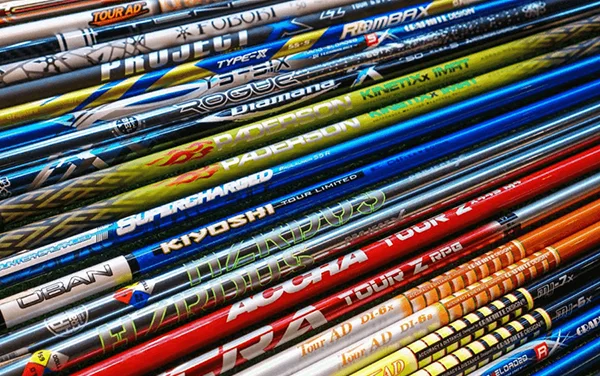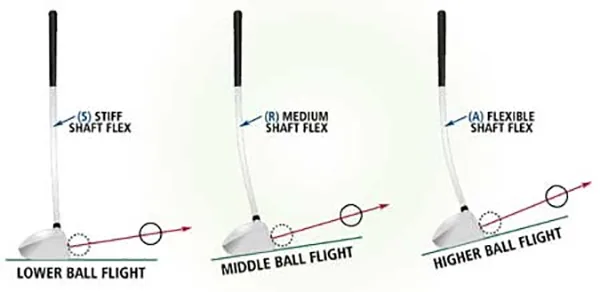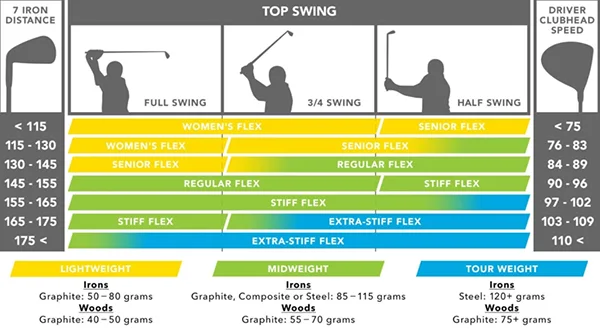
Golf can be a daunting sport, so be sure you have the proper equipment to maximize your success. The shaft of a golf club is one of the most important components in determining how the club behaves during a swing.
The flex of the shaft is an important consideration, with variations ranging from stiff to normal. Choosing the proper shaft for you can be difficult, but it’s critical if you want to get the most out of your game.
We’ll take a deep dive into decoding golf shafts in this post to help you pick between stiff and regular flex for the best performance.

Golf shafts are a critical component of your golf club, playing a crucial role in shaping your performance on the course. These slender, tubular structures connect the club head to the grip, transmitting your swing’s energy and influencing various aspects of your game.
When assessing golf shafts, three fundamental elements demand careful consideration: shaft weight, length, and material. These three elements will determine the amount of force exerted while you swing, and how that force is distributed.
Shaft weight plays a significant role in swing speed and distance. Lighter shafts allow for increased swing speed, generating more clubhead velocity and potentially resulting in greater distance.
Conversely, heavier shafts may offer more control and stability, but could potentially sacrifice some swing speed. Balancing the weight of the shaft with your swing characteristics and desired outcomes is essential in optimizing your performance.
Shaft length is another crucial factor in shaping your performance. Longer shafts generally enable greater potential for swing speed and distance, as they provide a longer lever to generate power.
However, longer shafts may also require more control and coordination to maintain accuracy. On the other hand, shorter shafts may promote better control but could sacrifice some potential distance. It’s important to find the right balance that suits your swing mechanics and goals.
The choice of shaft material significantly influences the feel and feedback you experience during your swing. Graphite shafts, known for their lightweight and vibration-dampening properties, often offer a smoother and more responsive feel.
They can absorb shock and reduce vibrations, resulting in enhanced comfort and feedback. In contrast, steel shafts tend to be stiffer and provide a more solid and direct feel, transferring more energy from the swing to the ball. The choice between graphite and steel depends on your personal preference, playing style, and desired feedback from your shots. There are many golf shaft options available online with world-renowned brands.
Shaft Flex is determined by the combination of three key elements: shaft travel, club weight, and swing mechanics.
For instance, a stiffer shaft will require more force to move it through the swing, which increases the speed of the club head at impact.
Contradictory to that, less force is required for those who have a regular flex shaft which results in a slower head speed.
You will have to gain experience and learn the relationship between those factors that how they affect performance. Once you have attained that experience and learning, you are good to go and can choose the right flex for our game.

Understanding the differences between stiff flex and regular flex in golf can have a huge impact on your game and help you make smart equipment purchases.
Stiff flex shafts are intended for more experienced golfers with high club head speeds. Regular flex shafts, on the other hand, are best suited to players with a medium swing speed.
Continue reading for a full comparison of stiff flex versus standard flex in golf to help you decide which option is best for your game.
Stiff flex golf shafts deliver powerful shots and are often preferred by players looking for extra distance. They can be a real ‘shot in the arm’ for the experienced golfer. Stiff flex shafts are designed to generate more speed and power for the golfer.
The key features of stiff flex shafts include:
Regular flex shafts also have a longer lifespan, making them a solid alternative for golfers seeking endurance and longevity. Their design and materials are intended to resist the rigors of daily operation, ensuring that the shafts retain their performance qualities over time.
Another advantage of regular flex shafts is their suitability for customization. Golfers who prefer to fine-tune their clubs to match their specific preferences and playing style will find regular flex shafts accommodating. Many of the top shaft brands offer regular flex shafts, so you can choose from a wide variety of options that suit your game.
When it comes to golf shafts, the only dependable approach to establish the appropriate shaft flex for your playing style and ability level is through trial and error.
Clubs should be tailored to your specific requirements, and the length, weight, and flex of the shaft all influence how well you perform. Investing effort in determining the best combination of shaft flex, length, and weight can mean the difference between feeling confident in your swing and being unhappy with your development.

Your swing speed determines the suitability of whether a regular golf shaft or a stiff golf shaft is the one for you. Some of the factors that determine this for you are swing mechanics, shaft length, and the fitting of the club.
If you are a golf player with a slightly slower swing speed, you will be highly benefitted by a regular flex shaft, on the other hand, just opposite to this if you are a player with a faster swing speed, you can get benefitted from a stiff shaft. A shift staff can get you more distance from your fast pace drives.
The shaft length, launch angle, and swing speed all contribute to establishing which flex is optimal for you according to your skill level and playing style. For example, if you’re a beginner, you might want to go for a standard flex shaft for more forgiveness. If you’re more experienced, a stiffer flex may be preferable to provide more power and accuracy.
Furthermore, if you want to play with a higher launch angle, a stiffer flex shaft may be required to guarantee the ball launches properly.
If you prefer a lower launch angle, you may be better off using a standard flex shaft to cause the ball to launch lower.
Choosing the right golf shaft flex is crucial for optimal performance on the course. The decision between stiff flex and regular flex depends on factors such as swing speed, skill level, and playing style.
Stiff flex shafts offer increased power, control, and distance for experienced golfers with high swing speeds. Regular flex shafts provide durability, customization options, and forgiveness for players with average swing speeds.
To find the perfect flex, consider your swing speed, skill level, and preferred playing style, and seek guidance from a club fitter. Experimentation and customization will help you find the optimal shaft flex to enhance your game.
